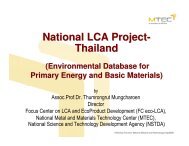ILCD Handbook: Framework and requirements for LCIA models and ...
ILCD Handbook: Framework and requirements for LCIA models and ...
ILCD Handbook: Framework and requirements for LCIA models and ...
Create successful ePaper yourself
Turn your PDF publications into a flip-book with our unique Google optimized e-Paper software.
<strong>ILCD</strong> <strong>H<strong>and</strong>book</strong>: <strong>Framework</strong> <strong>and</strong> <strong>requirements</strong> <strong>for</strong> <strong>LCIA</strong> <strong>models</strong> <strong>and</strong> indicators First edition<br />
A – Full compliance<br />
B – Compliance in all essential aspects<br />
C – Compliance in some aspects (or acceptable agreement made)<br />
D – Little compliance<br />
E – No compliance.<br />
For the overall evaluation of the characterisation model, the importance of each criterion<br />
<strong>and</strong> sub-criterion is assessed <strong>for</strong> the impact category in question. A differentiation between<br />
normal (N) <strong>and</strong> high (H) importance is applied. Criteria of high importance are criteria which<br />
significantly differentiate the different <strong>models</strong> from each other <strong>and</strong> which address key aspects<br />
<strong>for</strong> the resulting characterisation factors.<br />
For some of the sub-criteria, it is relevant to define an exclusion threshold as a required<br />
minimum per<strong>for</strong>mance. Whenever a characterisation model fails to pass such an exclusion<br />
threshold, the subsequent analysis of that characterisation model is not per<strong>for</strong>med.<br />
2.2.4 Development of criteria <strong>for</strong> the evaluation of endpoint<br />
<strong>models</strong><br />
Discussions on midpoint vs. endpoint modelling started under the umbrella of the US EPA<br />
<strong>and</strong> UNEP <strong>and</strong> continued within the Life Cycle Initiative 5 , a joint project between UNEP <strong>and</strong><br />
SETAC, where a comprehensive LCA framework has been proposed to combine midpointoriented<br />
<strong>and</strong> damage-oriented approaches in a common <strong>and</strong> consistent framework. The<br />
present chapter focuses on the assessment of midpoint <strong>and</strong> endpoint categories <strong>for</strong> a set of<br />
<strong>LCIA</strong> impact categories, building on the latest outcomes of the Life Cycle Initiative on this<br />
issue 6 .<br />
The general criteria in Chapter 2 also apply <strong>for</strong> the evaluation of characterisation <strong>models</strong><br />
linking midpoint impacts to impacts on the Areas of Protection (endpoint characterisation<br />
<strong>models</strong>). In addition, to ensure environmental relevance across the different midpoint impact<br />
indicators <strong>and</strong> a consistent <strong>and</strong> common approach to midpoint-damage modelling, the<br />
following guidelines specific to midpoint-damage modelling shall be considered in the<br />
development of specific criteria <strong>for</strong> endpoints (compare with Margni et al., 2008):<br />
The goal of damage modelling is to aid in underst<strong>and</strong>ing <strong>and</strong> interpreting midpoints. It<br />
aims to make results in different midpoint categories cross-comparable within Areas of<br />
Protection using, as far as possible, natural science approaches, <strong>and</strong> not necessarily to<br />
arrive at a single score. It can then replace or support weighting practices in the<br />
midpoint approaches. In some cases, a scientific approach <strong>for</strong> midpoint factors which<br />
are truly cross-comparable even within an impact category, does not exist. In such<br />
cases, endpoint approaches will be necessary, which should avoid implicit value<br />
judgements.<br />
All modelling (midpoint <strong>and</strong> endpoint) should ideally be properly documented on<br />
uncertainty <strong>and</strong> reliability. The choice to go to the damage/endpoint level is to be<br />
maintained, as is to eventually come to different recommendations depending on the<br />
context/application <strong>and</strong> to increase transparency. In this sense the framework should<br />
enable both (midpoint <strong>and</strong> damage) in a consistent way.<br />
5 See Bare et al. 1999, 2000 <strong>and</strong> Jolliet et al., 2004<br />
6 See Margni et al., 2008<br />
2 Development <strong>and</strong> Application of the Criteria <strong>for</strong> Evaluation 12



